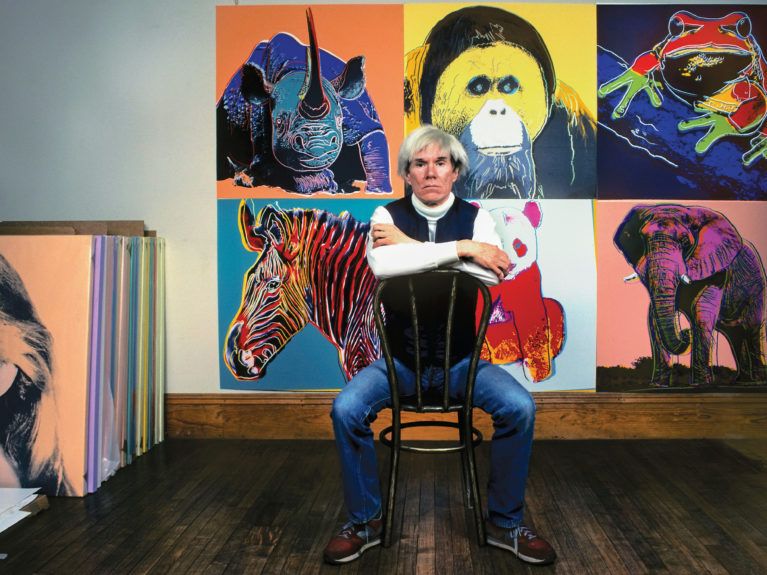
Andy Warhol
Buy original Andy Warhol artworks from ArtLife, including rare paintings, screenprints, and signed limited editions spanning his Pop Art career. Explore Warhol’s groundbreaking works featuring icons like Marilyn Monroe, Campbell’s Soup, and Mick Jagger. Learn more about Andy Warhol’s life, artistic legacy, and influence on contemporary art while browsing exclusive pieces available to collectors and investors worldwide.
Biography
Born Andrew Warhola on 6th August 1928, Andy Warhol was the child of Ondrej and Julia Warhola, emigrants from Mikó, Austria-Hungary—now Miková in northeastern Slovakia. He grew up in Pittsburgh, Pennsylvania with his two older brothers Pavol (Paul) and Ján (John).
Warhol studied commercial art at Pittsburgh’s Carnegie Institute of Technology, where he also served as the art director of Cano, the student art magazine. After graduating in 1949, he moved to New York City to work in magazine advertising and illustration and was commissioned by publications including Vogue and Glamour. He also worked in the shoe industry, acting as a designer for the Israel Miller brand. It was his time in the business sector that enabled him to conceptualize the silk screen printmaking process as a means of making art, as well as perfecting his unique blotted line technique, and coming to see the merits of a more commercial approach to art.
The 1950s saw Warhol host a number of exhibitions which helped establish his name in the art world. His first solo show was called Fifteen Drawings Based on the Writings of Truman Capote, exhibited at New York’s Hugo Gallery in 1952. A decade later, one of his most enduring pop artworks, Campbell’s Soup Cans, debuted at the Ferus Gallery of Los Angeles, and later that year, he displayed Marilyn Diptych—his iconic pair of silkscreen portraits of Marilyn Monroe—at his first solo pop art exhibition in New York.
The 1964 exhibition, The American Supermarket, was a pivotal event in Warhol’s career. Held at Paul Bianchini’s Upper East Side gallery, the space was presented as a small supermarket in which everything, from canned goods to posters on the wall, had been created by one of six prominent pop artists, including Billy Apple and Robert Watts.
In the early sixties, Warhol relocated his studio to 231 East 47th Street—the legendary Factory—which became a cultural hub for artists, musicians and other creatives, Mick Jagger and The Velvet Underground. Warhol also went on to design the statement album artwork for The Velvet Underground & Nico and The Rolling Stones’ first album of the 1970s, Sticky Fingers.
He moved his studio again in 1967 to The Decker Building at 33 Union Square West where, a year later, he almost lost his life. Radical feminist writer Valerie Solanas, who had been a marginal figure in the Factory scene, shot Warhol and art critic Mario Amaya on 3rd June 1968. She turned herself in to the police, claiming that the artist “had too much control over [her] life”, and was subsequently diagnosed with paranoid schizophrenia. The incident was extremely serious, with surgeons having to open Warhol’s chest and massage his heart in order to save him. Following his recovery, he was required to wear a surgical corset for the rest of his life. The shooting also inspired Factory denizen Lou Reed’s classic glam rock song “Andy’s Chest”.
The 70s was a quieter decade for Warhol, and he dedicated much of his time to obtaining new portrait commissions from the rich and famous, including Chinese Communist leader Mao Zedong, John Lennon, and Brigitte Bardot. With his friend Stuart Pivar, he also founded the New York Academy of Art. And although he spent most of his time living and working at the new Factory, the decade saw him become a regular fixture at the newly-opened New York club Studio 54.
Days after undergoing gallbladder surgery, Warhol died at the age of 58 on 22nd February 1987 in Manhattan. Although he seemed to be making a good recovery, he died from a sudden postoperative irregular heartbeat. Warhol was buried in St. John the Baptist Byzantine Catholic Cemetery in suburban Pittsburgh, and a subsequent memorial hosted at St. Patrick’s Cathedral in New York City was attended by thousands of people.
Unlike the Abstract Expressionists who dominated the American artistic landscape post-World War II, Warhol set himself apart by turning consumer culture into high art, archly noting: “Buying is more American than thinking, and I’m as American as they come”. Rather than making art for the wealthy, he rooted his work on advertising and celebrity culture in order to target the masses. And thanks to his reliance on the mechanical silk-screening process, he could churn out prints in an assembly line style, hence the name of his studio.
His blurring of the lines between art and commodification made him a controversial figure amongst his peers, who despised him for embracing market culture so openly. In December 1962, the Museum of Modern Art even hosted a symposium on pop art, where Warhol and similar artists were scolded for “capitulating” to consumerism.
Nevertheless, Warhol was catapulted to stardom as a result of his celebration of capitalism, and he is still hugely relevant to today’s society as a symbol of the start of global consumerism. His legacy lives on, with contemporary artists including Jeff Koons, Takashi Murakami and Damien Hirst all citing Warhol’s work as inspiration. Thanks to his unconventional style and willingness to take risks, he went on to become as famous as the celebrities in his portraits.
Warhol’s work has never fallen out of style, and the high prices his prints still sell for the show just how important his impact remains to contemporary society. We have an exclusive collection of his original pieces. In addition to his most famous works, we also carry some of his lesser-known—yet, still equally remarkable—pieces, such as his Endangered Species series and his Camouflage series, Warhol’s final contribution to pop art before his death.
